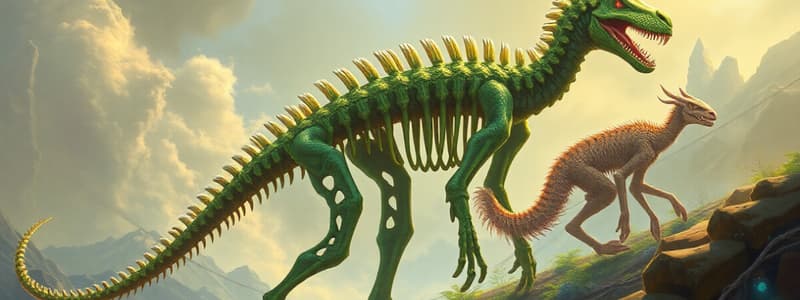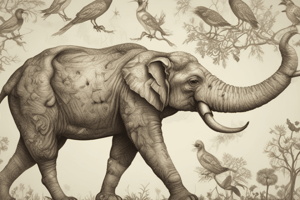Podcast
Questions and Answers
What does the branch length in some phylogenetic trees represent?
What does the branch length in some phylogenetic trees represent?
- The relative chronology of branching events
- The number of changes in a DNA sequence (correct)
- The absolute time since the common ancestor
- The total lifespan of the lineages
What principle suggests looking for the simplest explanation that fits the facts in phylogenetic analysis?
What principle suggests looking for the simplest explanation that fits the facts in phylogenetic analysis?
- Principle of maximum parsimony (correct)
- Principle of genetic variability
- Maximum likelihood
- Maximum divergence theory
In phylogenetic trees, what is generally implied by the branching pattern?
In phylogenetic trees, what is generally implied by the branching pattern?
- Precise absolute timing of events
- Equal length of all lineages
- Relative timing of branching events (correct)
- Species evolution rate
If the branch length leading to Drosophila is longer than that leading to the mouse, what can be inferred?
If the branch length leading to Drosophila is longer than that leading to the mouse, what can be inferred?
How many different ways can trees be formed when analyzing data for 50 species?
How many different ways can trees be formed when analyzing data for 50 species?
What type of ancestor do humans and bacteria share?
What type of ancestor do humans and bacteria share?
What does the principle of maximum likelihood help systematists with?
What does the principle of maximum likelihood help systematists with?
What does more genetic change in a lineage indicate based on branch length?
What does more genetic change in a lineage indicate based on branch length?
What are sister taxa?
What are sister taxa?
What happens to orthologous genes after speciation?
What happens to orthologous genes after speciation?
What does a rooted tree represent in phylogenetics?
What does a rooted tree represent in phylogenetics?
What characterizes a basal taxon?
What characterizes a basal taxon?
Which of the following best describes paralogous genes?
Which of the following best describes paralogous genes?
How does gene count compare to phenotypic complexity in humans and yeast?
How does gene count compare to phenotypic complexity in humans and yeast?
What does a polytomy indicate in a phylogenetic tree?
What does a polytomy indicate in a phylogenetic tree?
What is the main purpose of molecular clocks in evolutionary biology?
What is the main purpose of molecular clocks in evolutionary biology?
What does the sequence of branching in a phylogenetic tree signify?
What does the sequence of branching in a phylogenetic tree signify?
What provides useful information about a species' phylogeny?
What provides useful information about a species' phylogeny?
What is true about the nucleotide substitutions in orthologous genes?
What is true about the nucleotide substitutions in orthologous genes?
What are homologies in the context of evolution?
What are homologies in the context of evolution?
How many genes do humans share with mice as orthologous genes?
How many genes do humans share with mice as orthologous genes?
What is a common feature of living organisms regarding gene functions?
What is a common feature of living organisms regarding gene functions?
What accounts for morphological divergence among closely related species?
What accounts for morphological divergence among closely related species?
What factors can influence the evolution of paralogous genes?
What factors can influence the evolution of paralogous genes?
What is the primary purpose of graphing genetic differences against evolutionary branch points?
What is the primary purpose of graphing genetic differences against evolutionary branch points?
Why are some molecular clocks considered more accurate than others?
Why are some molecular clocks considered more accurate than others?
Which of the following statements best describes the neutral theory of molecular evolution?
Which of the following statements best describes the neutral theory of molecular evolution?
What can affect the rate of change in molecular clocks across different genes?
What can affect the rate of change in molecular clocks across different genes?
What percentage of amino acid differences in Drosophila species proteins is attributed to directional natural selection?
What percentage of amino acid differences in Drosophila species proteins is attributed to directional natural selection?
What is a potential explanation for fluctuations in the rate of mutation accumulation?
What is a potential explanation for fluctuations in the rate of mutation accumulation?
Which of the following is NOT a factor that can influence the accuracy of molecular clocks?
Which of the following is NOT a factor that can influence the accuracy of molecular clocks?
How do gene mutation rates vary among different types of genes?
How do gene mutation rates vary among different types of genes?
What is a primary concern of biologists regarding molecular clocks?
What is a primary concern of biologists regarding molecular clocks?
What advantage does using many genes provide when calibrating molecular clocks?
What advantage does using many genes provide when calibrating molecular clocks?
How has the molecular clock approach been applied to HIV research?
How has the molecular clock approach been applied to HIV research?
What type of genetic material does HIV possess?
What type of genetic material does HIV possess?
What system did early taxonomists primarily use to classify species?
What system did early taxonomists primarily use to classify species?
What did the discovery of genetic data reveal about the five-kingdom system?
What did the discovery of genetic data reveal about the five-kingdom system?
What taxonomic system has replaced the five-kingdom system?
What taxonomic system has replaced the five-kingdom system?
What supports the validity of the three-domain system?
What supports the validity of the three-domain system?
Which domain contains most of the currently known prokaryotes?
Which domain contains most of the currently known prokaryotes?
What characterizes the domain Archaea compared to Bacteria?
What characterizes the domain Archaea compared to Bacteria?
What does the kingdom Monera currently represent in taxonomy?
What does the kingdom Monera currently represent in taxonomy?
Which of the following statements best describes the relationship between Eukaryotes and Archaea?
Which of the following statements best describes the relationship between Eukaryotes and Archaea?
What evidence supports the evolutionary relationships in the tree of life?
What evidence supports the evolutionary relationships in the tree of life?
What is horizontal gene transfer?
What is horizontal gene transfer?
What discovery is made regarding metabolic genes in yeast compared to other organisms?
What discovery is made regarding metabolic genes in yeast compared to other organisms?
Why is the study of single-celled organisms significant in evolutionary history?
Why is the study of single-celled organisms significant in evolutionary history?
Flashcards
Sister taxa
Sister taxa
Groups of organisms sharing an immediate common ancestor, each other's closest relatives.
Rooted tree
Rooted tree
Phylogenetic tree including the most recent common ancestor of all taxa.
Basal taxon
Basal taxon
Lineage diverging early in a group's history, branching near the common ancestor.
Polytomy
Polytomy
Branch point on a phylogenetic tree from which more than two groups emerge, due to limited understanding of relationships.
Signup and view all the flashcards
Homologies
Homologies
Phenotypic and genetic similarities due to shared ancestry.
Signup and view all the flashcards
Phylogenetic trees
Phylogenetic trees
Show patterns of descent, not phenotypic similarity. Branching order reflects descent, not age.
Signup and view all the flashcards
Phylogenetic tree use
Phylogenetic tree use
Phylogenies can reveal closely related species with beneficial traits for genetic transfer to cultivated plants or identify illegally harvested species.
Signup and view all the flashcards
Morphological divergence
Morphological divergence
Differences in form between closely related species, possibly due to few genetic differences or different environmental pressures.
Signup and view all the flashcards
Phylogenetic tree branch lengths
Phylogenetic tree branch lengths
In some trees, branch lengths represent rates of change or time, while in others, they don't hold any specific meaning.
Signup and view all the flashcards
Relative vs. absolute chronology
Relative vs. absolute chronology
Phylogenetic trees show evolutionary relationships, but their branching order only tells us which events came earlier or later, not the precise timing.
Signup and view all the flashcards
Maximum Parsimony
Maximum Parsimony
The principle of selecting the simplest explanation that fits observed data when reconstructing evolutionary relationships.
Signup and view all the flashcards
Shared derived characters
Shared derived characters
Characteristics that were present in an ancestor and then changed in its descendants, being a unifying feature when comparing phylogenies.
Signup and view all the flashcards
Base changes in phylogenies
Base changes in phylogenies
Comparing base changes in DNA sequences (e.g., A, T, G, C) helps to determine relationships among groups.
Signup and view all the flashcards
Phylogenetic tree complexity
Phylogenetic tree complexity
As data (e.g. DNA sequences) increases, the possible tree shapes multiply exponentially, making accurate analysis challenging.
Signup and view all the flashcards
Common ancestry survival
Common ancestry survival
All lineages, despite the long stretches of time, have a common ancestor.
Signup and view all the flashcards
Fossil/Genetic evidence
Fossil/Genetic evidence
Fossils and DNA information combine to understand the history of life on Earth.
Signup and view all the flashcards
Orthologous genes
Orthologous genes
Genes found in different species which diverged after speciation, though they may have similar functions.
Signup and view all the flashcards
Paralogous genes
Paralogous genes
Genes within the same species that diverged after gene duplication, potentially carrying out distinct tasks.
Signup and view all the flashcards
Molecular clock
Molecular clock
A method to estimate evolutionary time based on the rate of genetic change in orthologous genes.
Signup and view all the flashcards
Evolutionary change rate
Evolutionary change rate
The rate at which genes and genomes change over time, important for understanding evolutionary relationships.
Signup and view all the flashcards
Divergence time
Divergence time
The time elapsed since two species shared a common ancestor, revealed through molecular comparisons.
Signup and view all the flashcards
Orthologous gene similarity
Orthologous gene similarity
High percentage similarity between orthologous genes in different species indicates a shared evolutionary history and ancestry, reflecting conserved roles.
Signup and view all the flashcards
Human and yeast gene similarity
Human and yeast gene similarity
A substantial proportion of human genes have orthologs in yeast, demonstrating the fundamental conservation of biological processes across vastly different life forms.
Signup and view all the flashcards
Gene duplication
Gene duplication
A process where a section of DNA is copied, leading to an extra copy of a gene which then can evolve different functions.
Signup and view all the flashcards
Neutral Theory
Neutral Theory
The idea that many genetic changes are neutral and have little or no impact on fitness, leading to a clock-like rate of change.
Signup and view all the flashcards
Genetic Drift
Genetic Drift
Random changes in the frequency of genes in a population, affecting the molecular clock.
Signup and view all the flashcards
Selective Neutrality
Selective Neutrality
The assumption that most changes used in the molecular clock are not influenced by natural selection.
Signup and view all the flashcards
Rate of Genetic Change
Rate of Genetic Change
The speed at which genetic differences accumulate in a gene, influencing the molecular clock.
Signup and view all the flashcards
Directional Selection
Directional Selection
Natural selection favoring a specific trait, potentially affecting the accuracy of the molecular clock.
Signup and view all the flashcards
Importance of the Gene
Importance of the Gene
The impact of a gene's function on survival determines its rate of change, affecting the molecular clock.
Signup and view all the flashcards
Long-Term Fluctuations
Long-Term Fluctuations
Over long evolutionary periods, fluctuations in the rate of genetic change due to natural selection tend to even out.
Signup and view all the flashcards
Molecular Clock Skepticism
Molecular Clock Skepticism
Biologists are wary of conclusions derived from molecular clocks for time spans beyond fossil record calibration, as these clocks assume consistent rates over vast periods, introducing uncertainty.
Signup and view all the flashcards
Molecular Clock Calibration
Molecular Clock Calibration
Using a multitude of genes to construct molecular clocks can minimize the impact of variable evolutionary rates, leading to more accurate estimates of divergence times.
Signup and view all the flashcards
HIV-1 M Origin
HIV-1 M Origin
Molecular clock analysis suggests that the most common HIV strain, HIV-1 M, likely infected humans in the 1930s, based on viral samples collected over time.
Signup and view all the flashcards
Three-Domain System
Three-Domain System
The three domains—Bacteria, Archaea, and Eukarya—represent a higher taxonomic level than kingdoms, encompassing all life forms. This system recognizes the deep evolutionary split between prokaryotes.
Signup and view all the flashcards
Early Kingdoms
Early Kingdoms
Historically, organisms were classified into two kingdoms: plants and animals. Later, a five-kingdom system emerged, adding Monera (prokaryotes), Protista, Fungi, and Animalia.
Signup and view all the flashcards
Prokaryotic Diversity
Prokaryotic Diversity
Genetic analyses revealed that some prokaryotes differ as much from each other as they do from eukaryotes, prompting a reevaluation of the five-kingdom system.
Signup and view all the flashcards
Genomic Support for Domains
Genomic Support for Domains
Analyses of numerous fully sequenced genomes provide strong evidence for the validity of the three-domain system, supporting the profound separation between Bacteria, Archaea, and Eukarya.
Signup and view all the flashcards
Revising the Tree of Life
Revising the Tree of Life
Our understanding of the tree of life is constantly being updated as new data emerges, leading to modified classifications and a deeper appreciation for the relationships among all living things.
Signup and view all the flashcards
Three Domains of Life
Three Domains of Life
The three primary branches of life on Earth: Bacteria, Archaea, and Eukarya. Each domain possesses unique cellular structures, biochemical processes, and evolutionary histories.
Signup and view all the flashcards
Prokaryotes
Prokaryotes
Organisms lacking a true nucleus and membrane-bound organelles. Bacteria and Archaea are prokaryotes.
Signup and view all the flashcards
Eukaryotes
Eukaryotes
Organisms with cells containing a true nucleus and membrane-bound organelles. Plants, animals, fungi, and protists are all eukaryotes.
Signup and view all the flashcards
Horizontal Gene Transfer (HGT)
Horizontal Gene Transfer (HGT)
The transfer of genetic material between organisms that are not direct ancestors or descendants. This process can occur through mechanisms like transposable elements, plasmid exchange, and viral infection.
Signup and view all the flashcards
The 'Tree of Life' - What does it show?
The 'Tree of Life' - What does it show?
A diagram that depicts the evolutionary relationships between all living organisms. The branching pattern represents the evolutionary history and common ancestry of different species.
Signup and view all the flashcards
rRNA Genes
rRNA Genes
Genes that code for ribosomal RNA, a crucial component of ribosomes involved in protein synthesis. rRNA genes are used extensively in phylogenetic analysis.
Signup and view all the flashcards
What makes Eukarya & Archaea closer than to Bacteria?
What makes Eukarya & Archaea closer than to Bacteria?
Phylogenetic studies based on rRNA genes, as well as other genetic analyses, suggest that Eukarya and Archaea are more closely related to each other than either is to Bacteria.
Signup and view all the flashcards
Early Life: Gene Swaps
Early Life: Gene Swaps
During the early stages of life, horizontal gene transfer was prevalent, leading to significant exchange of genetic material between different domains. This resulted in a more complex and dynamic evolutionary landscape.
Signup and view all the flashcardsStudy Notes
Evolutionary Biology
- Evolutionary biology investigates both the process and pattern of evolution
- Processes include natural selection and other mechanisms changing population genetics
- Patterns are the products of evolution over time
Phylogeny
- Phylogeny is the evolutionary history of species or groups
- Systematics is an analytical approach to classify diversity and determine evolutionary relationships between living and extinct organisms
- Evidence for reconstructing phylogeny involves fossil record, morphological, biochemical, and genetic similarities
- Scientists are continuously refining the universal tree of life based on new data
Taxonomy
- Taxonomy is the science of naming and classifying organisms
- The Linnaean system, proposed by Carolus Linnaeus, uses two-part names (binomial) for organisms, organized hierarchically (e.g., species, genera, family, order, class, phylum, kingdom, domain)
Phylogenetic Trees
- Phylogenetic trees are diagrams illustrating evolutionary relationships
- Branch points (nodes) represent evolutionary divergence from common ancestors
- Sister taxa are groups sharing an immediate common ancestor
- Rooted trees show the most recent common ancestor of all taxa
- Basal taxa diverge early in the history of a group
- Polytomies represent unresolved evolutionary relationships
Inferring Phylogenies
- Homologies are similarities due to shared ancestry
- Organisms with similar morphologies or DNA sequences are likely closely related
- Analogies are similarities due to convergent evolution
- Analogy is due to similar environmental pressures leading to similar adaptations
- Identifying homologies is crucial for accurate phylogenetic reconstruction
- Molecular data can help resolve phylogenetic relationships, especially in cases with limited fossil record
Molecular Clocks
- Molecular clocks use constant rates of gene evolution to estimate absolute time of evolutionary events
- Maximum parsimony and maximum likelihood are principles used to infer phylogenies based on molecular and morphological data
- Maximum parsimony considers the simplest explanation (fewest evolutionary changes)
- Maximum likelihood models likely sequence of evolutionary events with given probability rules
- Molecular clocks can estimate divergence times, but they may not be entirely accurate due to deviations or fluctuations in rates over time
Phylogenetic Tree of Life
- Early classifications grouped species into plants and animals
- Modern classification systems now use three domains: Bacteria, Archaea, and Eukarya
- Horizontal gene transfer has played a significant role in evolution, particularly early on
- Some data have been interpreted as suggesting that a 'ring of life' might be more accurate than a simple tree
Studying That Suits You
Use AI to generate personalized quizzes and flashcards to suit your learning preferences.




